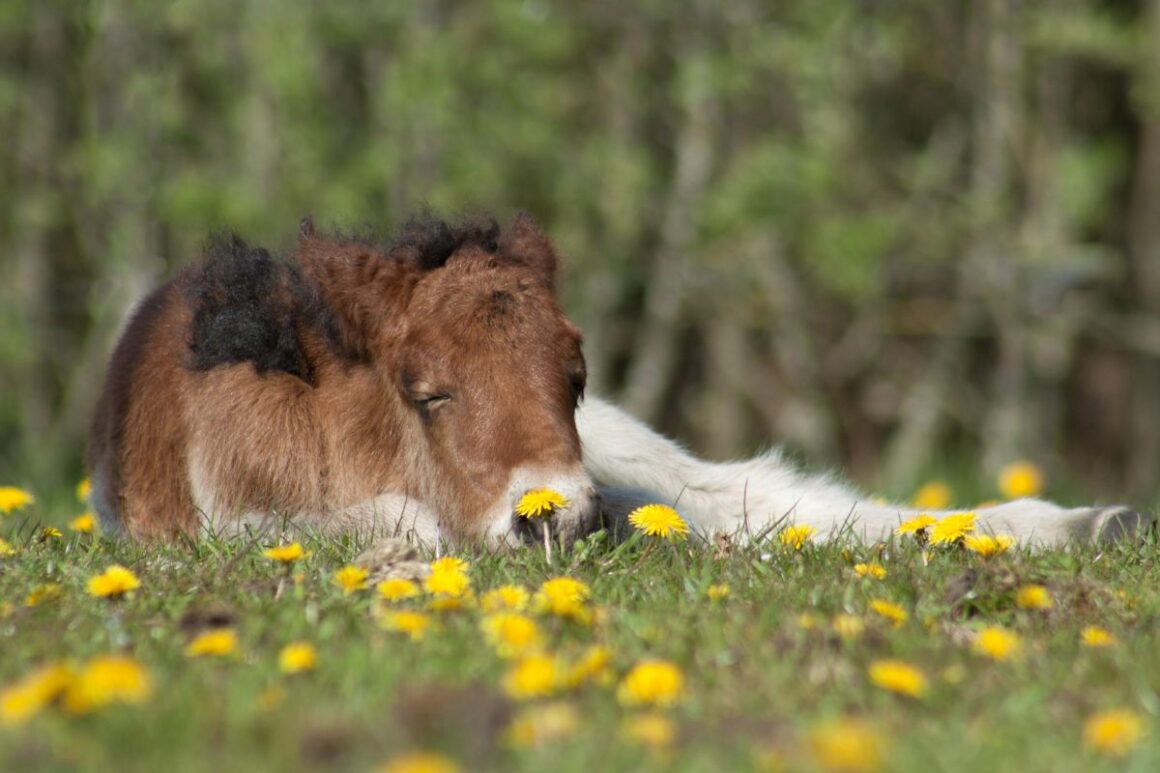How do horses sleep? If you ask that question, many will answer that they sleep standing up. But the answer is more complicated than that. Horses nap or doze standing up and require deep REM sleep (rapid eye movement) for 30 minutes a day to be fully rested. This REM sleep is only accomplished while lying down.

One of the greatest myths in the equestrian world is that horses sleep standing up, in part, because it’s true. While horses do doze and nap standing up, because of the stay apparatus, an intricate system of tendons, ligaments, and muscles, they also require rapid eye movement (REM) sleep, which they can only enter while lying down.
How Horses Sleep
Horses are prey animals, and as such, evolved over millions of years to best be able to survive on their own in the wild. How horses sleep is one evolutionary adaptation that has helped them survive and thrive in the wild. They can rest and nap while standing up, and this comprises most of their “sleep” time. This evolutionary adaptation allows them to quickly move again in the event of danger from a predator.
All horses also need to lie down and sleep for short amounts of time, typically 30 minutes per day. Horses seek a soft, quiet place for lying down – like us, they want a comfortable bed. They also seek the protection of their herd, in the wild, one horse will stand sentinel while the others rest. Horses lower on the herd’s pecking order won’t get as much sleep, and sleep deprivation can be a concern for both domesticated and wild horses.

The Stay Apparatus – Essential to How Horses Sleep
The stay apparatus is the intricate system of tendons, ligaments, and muscles that lock a horse’s legs and allow them to nap or doze while standing up. Horses’ legs are basically locked in place. One leg rests while the others support their body, and then they switch which leg is resting. This rests their muscles because they aren’t required to remain active when the stay apparatus is engaged.
In the front end, the stay apparatus automatically engages and is separate from the one in the hind end. Both allow the horses to rest their large muscle groups. Other animals like cattle also have this feature and use it to reduce fatigue while standing for long periods of time.

Sleep Requirements
A horse uses standing rest for anywhere from four to 15 hours per day, the research in this area is not as in-depth as some other equine studies. The stay apparatus powers this standing rest period, or what we think of as horses sleeping standing up. It prevents them from falling down while sleeping. This rest is essential to their health and well-being but must be accompanied by short periods of sleep lying down each day, about 30 minutes daily for deep REM sleep. As with humans, baby horses and youngsters sleep more deeply and more often than adult horses.
Unlike humans, equine rest can be scattered throughout the day. We need our REM sleep and rest in a solid eight-hour block. Horses require a much smaller amount of REM sleep – only 30 minutes – and they scatter their standing rest throughout the day, intermingled with grazing and other activities.
Equines can suffer from sleep deprivation if they don’t get adequate REM, and this can be dangerous. The legs of sleep-deprived horses buckle, and they can fall down, so it’s essential to ensure they receive adequate sleep.
Help Your Horse Get Better Sleep
Now that we know our horses need to sleep both lying down and standing up, there are steps that equestrians can take to help their horse get better sleep. First, we need to remember that horses are herd animals, and rely on that sentinel in the herd to feel safe lying down. Look for evidence that your horse lies down in its stall at night. If not, consider making some changes. These might be making other horses visible in their stalls or adding more bedding and making the stall more inviting. Horses like a soft place to sleep and need enough space to rise easily.
Quiet hours in the barn, usually at night and the early morning, are often the times when stabled horses get their REM sleep. We can help horses living in herds and outdoors too. Ensure there is enough room for horses lower on the pecking order to find a place to rest and sleep. Dominant horses will have a harder time bothering them this way. How horses sleep (and how much!) is different from humans but just as necessary.
Sources: Britannica, Kentucky Equine Research, National Library of Medicine, Power Naps, Practical Horseman, and the University of Adelaide.
